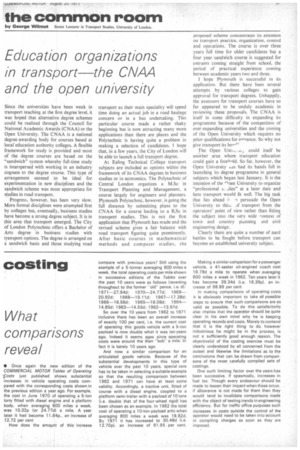costing What comparisons reveal
Page 39

If you've noticed an error in this article please click here to report it so we can fix it.
• Once again the new edition of the COMMERCIAL MOTOR Tables of Operating costs just published shows substantial increases in vehicle operating costs compared with the corresponding costs shown in the previous edition a year ago. For example, the cost in June 1970 of operating a 5-ton lorry fitted with diesel engine and a platform body, when averaging 600 miles a week, was 10.32p (or 24.77d) a mile. A year later it had become 11.64p., an increase of 12.72 per cent How does the amount of this increase compare with previous years? Still using the example of a 5-tonner averaging 600 miles a week, the total operating costs per mile shown in successive editions of the Tables over the past 10 years were as follows (reverting throughout to the former "old" pence, i.e. d): 1971-27.94d; 1970-24.77d; 196920.92d; 1968-19.11d; 1967-17.38d; 1966-16. 56d ; 1965-16.09d: 196414.85d: 1963-14.55d; 1962-13.97d.
So over the 10 years from 1962 to 1971 inclusive there has been an overall increase of exactly 100 per cent, i.e. the current cost of operating this goads vehicle with a 5-ton payload is now double what it was ten years ago. Indeed it seems ages since operating costs were around the then -bob" a mile. In fact it is barely 10 years ago.
And now a similar comparison for an articulated goods vehicle. Because of the substantial developments in this type of vehicle over the past 10 years, special care has to be taken in selecting a suitable example so that the resulting comparison between 1962 and 1971 can have at least some validity. Accordingly, a tractive unit, fitted of course with a diesel engine, coupled to a platform semi-trailer with a payload of 10 tons (i.e. double that of the four-wheel rigid) has been chosen as an example. In 1962 the total cost of operating a 10-ton-payload artic when averaging 800 miles a week was 18.82d. By 1971 it has increased to 30.48d (i.e. 12.70p), an increase of 61.95 per cent. Making a similar comparison for a passenger vehicle, a 41-seater oil-engined coach cost 19.78d a mile to operate when averaging 600 miles a week in 1962. Ten years later it has become 39.34d (i.e. 16.39p). an increase of 98.89 per cent In making comparisons of operating costs it is obviously important to take all possible steps to ensure that such comparisons are as valid as possible. To do this satisfactorily also implies that the operator should be quite clear in his own mind why he is keeping operating records and costs. Merely to contend that it is the right thing to do, however industrious he might be in the process, is not a sufficiently good enough reason. The objective(s) of the costing exercise must be clearly understood by all concerned from the outset and likewise the limitations as to the conclusions that can be drawn from comparisons of the most carefully compiled sets of costi ngs.
One such limiting factor over the years has been successive, if spasmodic, increases in fuel tax. Though every endeavour should be made to lessen their impact when these occur, if allowance is not made for them then they would tend to invalidate comparisons made with the object of testing trends in engineering efficiency. But for traffic office purposes such increases in costs outside the control of the operator would need to be taken into account in compiling charges as soon as they are imposed.




















































































